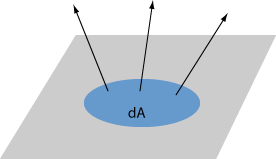Radiant Exitance
Definition: radiant flux emitted by a surface per unit area
Alternative term: radiant emittance
German: Ausstrahlung
Category: light detection and characterization
Formula symbol: Me
Units: W/m2, W/cm2
How to cite the article; suggest additional literature
Author: Dr. Rüdiger Paschotta

Radiant exitance (or emittance) is a term of radiometry and is defined as the radiant flux (optical power = energy per unit time) which is emitted by some surface (e.g. of a light source) per unit area. For example, if an optical power of 1 μW is radiated from an area of 1 m2, the radiant excitance is 1 μW / 1 mm2 = 1 W/m2.
In the SI system, the units of the radiant exitance are W/m2 (watts per square meter). The related term irradiance has the same units, but applies to received radiation.
A related quantity is the spectral exitance, which is the exitance per unit frequency or wavelength interval. It has units of W / (m2 Hz) or W / (m2 nm), for example.
The corresponding photometric quantity is the luminous exitance.
Example: Radiant Exitance of Blackbody Radiation
A prominent example is thermal radiation from a black body at temperature T, which according to Planck's law has a spectral radiance
from which one can calculate the spectral exitance by integration over all solid angles of a hemisphere:
If this is integrated over all frequencies, one obtains the Stefan–Boltzmann law for the radiant exitance of thermal radiation of a black body:
with the Stefan–Boltzmann constant σ ≈ 5.6704 · 10−8 W m−2 K−4.
Questions and Comments from Users
Here you can submit questions and comments. As far as they get accepted by the author, they will appear above this paragraph together with the author’s answer. The author will decide on acceptance based on certain criteria. Essentially, the issue must be of sufficiently broad interest.
Please do not enter personal data here; we would otherwise delete it soon. (See also our privacy declaration.) If you wish to receive personal feedback or consultancy from the author, please contact him e.g. via e-mail.
By submitting the information, you give your consent to the potential publication of your inputs on our website according to our rules. (If you later retract your consent, we will delete those inputs.) As your inputs are first reviewed by the author, they may be published with some delay.
See also: radiometry, irradiance
and other articles in the category light detection and characterization
 |



If you like this page, please share the link with your friends and colleagues, e.g. via social media:
These sharing buttons are implemented in a privacy-friendly way!